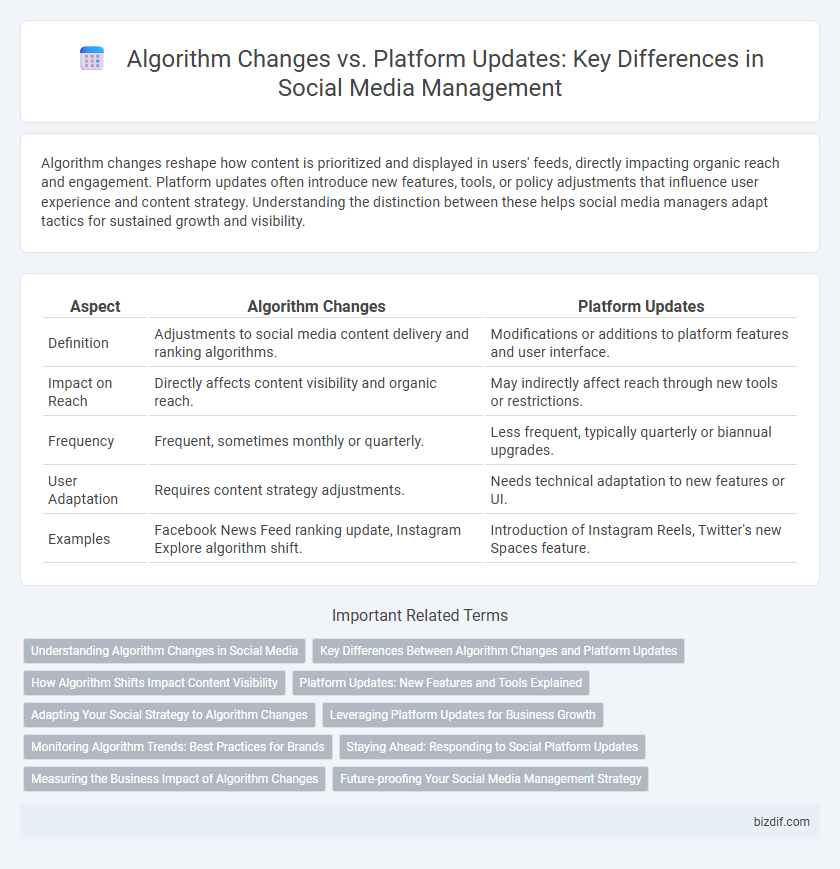Algorithm changes reshape how content is prioritized and displayed in users' feeds, directly impacting organic reach and engagement. Platform updates often introduce new features, tools, or policy adjustments that influence user experience and content strategy. Understanding the distinction between these helps social media managers adapt tactics for sustained growth and visibility.
Table of Comparison
| Aspect | Algorithm Changes | Platform Updates |
|---|---|---|
| Definition | Adjustments to social media content delivery and ranking algorithms. | Modifications or additions to platform features and user interface. |
| Impact on Reach | Directly affects content visibility and organic reach. | May indirectly affect reach through new tools or restrictions. |
| Frequency | Frequent, sometimes monthly or quarterly. | Less frequent, typically quarterly or biannual upgrades. |
| User Adaptation | Requires content strategy adjustments. | Needs technical adaptation to new features or UI. |
| Examples | Facebook News Feed ranking update, Instagram Explore algorithm shift. | Introduction of Instagram Reels, Twitter's new Spaces feature. |
Understanding Algorithm Changes in Social Media
Understanding algorithm changes in social media requires analyzing how platforms prioritize content based on user behavior, engagement metrics, and relevance signals. These algorithmic adjustments directly impact content visibility and audience reach, making it essential for social media managers to adapt strategies continuously. Staying informed about the nuances of algorithm updates helps optimize post timing, format, and targeting to maximize organic growth and user interaction.
Key Differences Between Algorithm Changes and Platform Updates
Algorithm changes primarily affect content visibility and engagement metrics by altering how posts are ranked and displayed in users' feeds, while platform updates introduce new features or interface modifications that enhance user experience or functionality. Understanding these distinctions enables social media managers to adapt strategies effectively, optimizing content performance through algorithm-friendly techniques while leveraging new tools from platform updates. Monitoring algorithm shifts requires analytical adjustments to posting times, formats, and interaction tactics, whereas platform updates demand technical adaptation and user training.
How Algorithm Shifts Impact Content Visibility
Algorithm shifts significantly affect content visibility by altering how posts are ranked and prioritized in users' feeds, often favoring certain content types or engagement patterns. These changes can reduce organic reach for businesses and creators, making it crucial to adapt strategies to maintain audience engagement. Understanding platform-specific algorithms enables more targeted content creation, improving visibility despite frequent updates.
Platform Updates: New Features and Tools Explained
Platform updates introduce new features and tools designed to enhance user experience and content management, often impacting how algorithms prioritize content. These updates can include advanced analytics dashboards, scheduling innovations, and interactive content formats like Stories or Reels. Understanding these changes enables social media managers to leverage platform capabilities effectively for improved engagement and strategic growth.
Adapting Your Social Strategy to Algorithm Changes
Algorithm changes on social media platforms directly impact content visibility and engagement rates, requiring constant adaptation of your posting schedule and content formats to maintain audience reach. Staying informed about platform updates enables marketers to leverage new features effectively while aligning their strategies with the latest algorithm priorities. Utilizing data analytics and real-time insights helps optimize content performance and ensures sustained growth despite fluctuating algorithmic criteria.
Leveraging Platform Updates for Business Growth
Platform updates offer new tools and features that can be strategically leveraged to amplify brand visibility and enhance audience engagement. Keeping pace with these updates enables businesses to optimize content distribution algorithms, ensuring higher organic reach and improved ROI on social media campaigns. Proactively adapting to platform changes fosters innovation in marketing strategies, driving sustained business growth and competitive advantage.
Monitoring Algorithm Trends: Best Practices for Brands
Monitoring algorithm trends involves continuous analysis of social media platforms' evolving ranking factors and content prioritization methods to maintain visibility and engagement. Brands should utilize advanced analytics tools to track performance metrics and adapt content strategies in real time, ensuring alignment with platform algorithms such as Instagram's feed ranking or TikTok's For You page curation. Regularly reviewing platform update announcements and industry insights enables proactive adjustment of campaign tactics, maximizing reach despite frequent algorithmic shifts.
Staying Ahead: Responding to Social Platform Updates
Algorithm changes and platform updates continuously reshape social media landscapes, demanding agile response strategies from managers to maintain visibility and engagement. Proactively monitoring trends and leveraging real-time analytics enable timely content adjustments aligned with evolving platform priorities. Implementing adaptive social media management tools and fostering collaborative content planning ensures sustained audience growth despite frequent algorithmic shifts.
Measuring the Business Impact of Algorithm Changes
Algorithm changes in social media platforms directly affect content visibility and engagement metrics, making it essential to analyze shifts in reach, impressions, and click-through rates. Platform updates often introduce new features or interface modifications that indirectly influence user behavior and content performance, requiring continuous monitoring of key performance indicators (KPIs). Measuring the business impact of algorithm changes involves correlating these fluctuations with conversion rates, customer acquisition costs, and overall ROI to optimize social media strategies effectively.
Future-proofing Your Social Media Management Strategy
Algorithm changes frequently alter content visibility and engagement metrics, requiring ongoing analysis and adaptation to maintain reach across major platforms like Facebook, Instagram, and TikTok. Platform updates introduce new features and interface modifications that can impact scheduling, analytics, and advertising strategies, necessitating continuous learning and flexible tools integration. Future-proofing your social media management strategy involves leveraging AI-driven analytics, diversifying content formats, and maintaining agility to quickly respond to both algorithm fluctuations and platform enhancements.
Algorithm changes vs Platform updates Infographic

 bizdif.com
bizdif.com